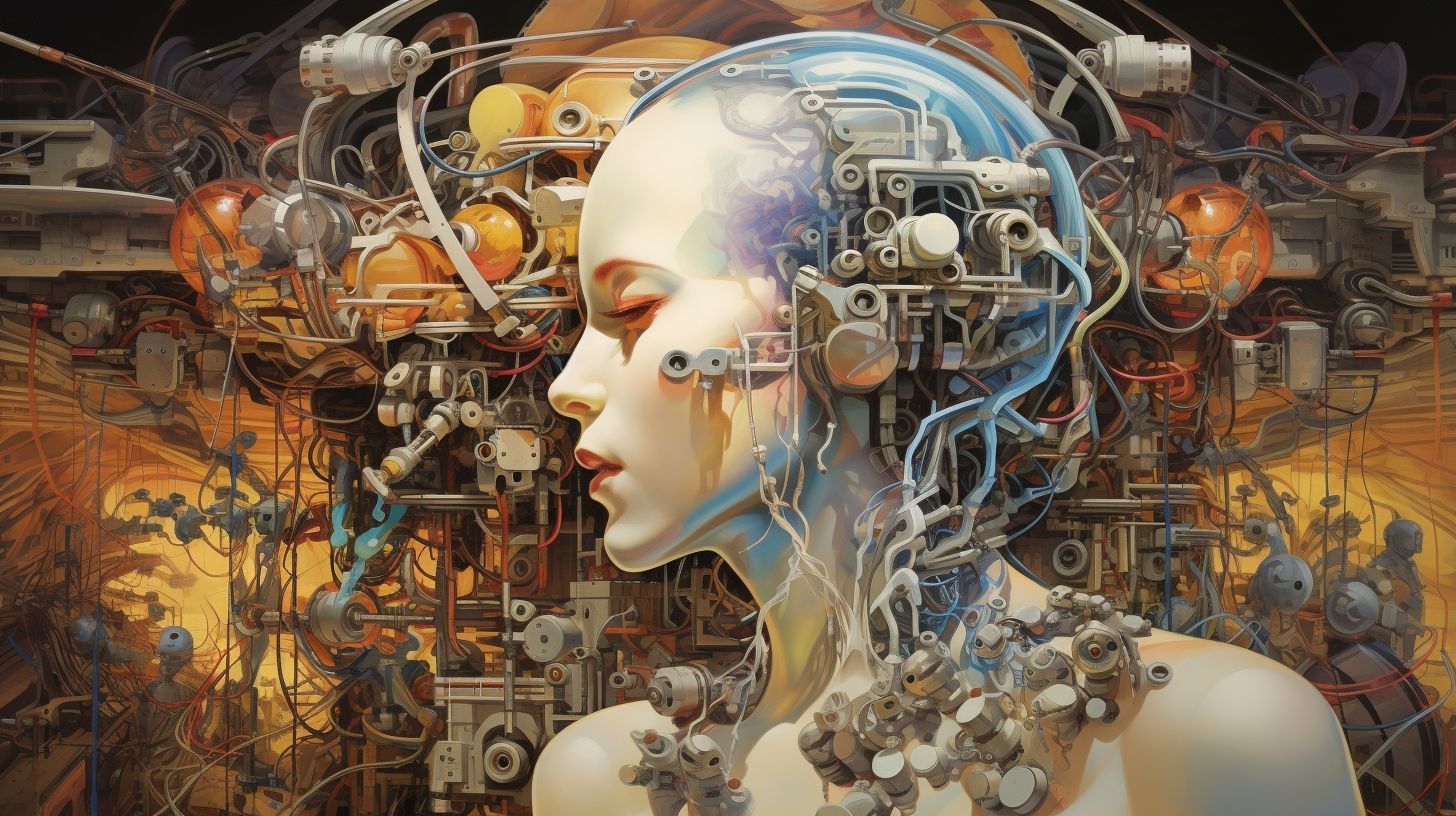Per la versione 🇮🇹 clicca qui

In his seminal essay “The Work of Art in the Age of Mechanical Reproduction,” Walter Benjamin deeply explored how the techniques of mechanical reproduction made possible by photography and cinema in the early 20th century radically transformed the status, aura, and value of artworks. Today, in the era of artificial intelligence, we find ourselves facing a new revolutionary turning point in the reproducibility of art, with even more disruptive consequences.
If in the transition from the uniqueness of the artisanal artefact to the technical serialization studied by Benjamin, the auratic “hic et nunc” (here and now) of the artwork was lost, today, with the advent of AI, this dematerialization of art reaches its culmination. Artificial intelligence enables not only the infinite reproduction of existing works but also the creation of completely new ones, devoid of an original and sacred uniqueness. Through sophisticated machine learning algorithms and deep neural networks, AI is capable of generating images, music, and texts that imitate and elaborate on various artistic styles and genres.

The Aura of Art in the Age of AI
According to Benjamin, mechanically reproducible art loses its “aura,” a term he used to indicate the uniqueness and authenticity of a work linked to its specific historical and material context. In the era of AI, we can question: what becomes of the aura of artworks? The creations produced by complex algorithms of automatic learning and deep learning, such as Generative Adversarial Networks (GANs), raise unprecedented questions about uniqueness and originality. If artwork is created by an algorithm, who is the true author? Is it the algorithm itself as an artificial agent, the programmer who wrote its code, or the starting datasets from which the machine learned? Can we still speak of an auratic aura when the work originates from a non-human intelligence?
If, for Benjamin, mechanically reproduced art lost its ritual authority, today it is the absence of the artist in the flesh and bones in the work generated by AI that completely dissolves that aura of uniqueness and authenticity. The artist no longer unambiguously shapes their creation but becomes a coordinator and trainer of intelligent machines that create independently.
The Function of Reproducibility in the Era of AI
Benjamin believed that mechanical reproducibility had transformed art from ritual into a political act capable of reaching the masses. Today, with the advent of AI, we witness a similar metamorphosis. Thanks to AI, architectural design is no longer the exclusive domain of a few professionals; intuitive and automated design tools potentially enable anyone to conceive and share their creations.
Digital reproducibility, combined with AI, greatly expands the field of creative possibilities in architecture, making design a democratic and participatory act. At the same time, AI allows for the generation of artworks and innovative projects that surpass human limits, questioning traditional notions of creativity and imagination.
Even the exhibition and aesthetic value of artworks, which Benjamin associated with the bourgeois institution of museums and galleries, are now redefined by the digital dematerialization of art and its potential global dissemination online. AI creations can be displayed in virtual galleries or on digital screens, reproduced infinitely, and accessible to a universal audience (ever heard of NFTs?).
AI and the Political Implications of Creation
For Benjamin, mechanical reproducibility was a tool of emancipation capable of freeing art from cultural elites. Nevertheless, the advent of AI brings forth new challenges and uncertainties. Who controls the algorithms that create art? What are the ethical implications of art generated by non-human intelligence? How can AI be manipulated for manipulation and disinformation?
These questions require thoughtful critical reflection. As Benjamin reminded us, technology is not neutral but deeply intertwined with the power structures of the society in which it develops.
In conclusion, if for Benjamin mechanical reproducibility inaugurated the politicized aesthetics of the avant-garde, today, with the proliferation of AI, we are moving towards a new “algorithmic aesthetics,” whose cultural and social consequences are yet to be fully understood. It is up to contemporary thinkers to develop updated analyses that reconsider the new meaning that an artwork holds in the era of artificial intelligence.
🇮🇹 version

Nel suo fondamentale saggio “L’opera d’arte nell’epoca della sua riproducibilità tecnica”, Walter Benjamin esaminava in profondità come le tecniche di riproduzione meccanica rese possibili dalla fotografia e dal cinema agli inizi del Novecento avessero radicalmente mutato lo status, l’aura e il valore delle opere d’arte. Oggi, nell’era dell’intelligenza artificiale, ci troviamo di fronte ad una nuova rivoluzionaria svolta nella riproducibilità dell’arte, con conseguenze ancora più dirompenti.
Se nel passaggio dall’unicità del manufatto artigianale alla serializzazione tecnica studiata da Benjamin si perdeva l’hic et nunc auratico dell’opera, oggi con l’avvento dell’IA tale dematerializzazione dell’arte giunge al suo compimento. L’intelligenza artificiale consente infatti non soltanto di riprodurre all’infinito opere già esistenti, ma di crearne di completamente nuove, prive di un originale e di un’unicità sacrale. Tramite sofisticati algoritmi di machine learning e reti neurali profonde, l’IA è in grado di generare immagini, musica, testi che imitano ed elaborano i più svariati stili e generi artistici.
L’aura dell’opera d’arte nell’era dell’IA
Secondo Benjamin, l’arte riproducibile meccanicamente perde la sua “aura”, termine con cui indicava l’unicità e autenticità di un’opera legata al suo specifico contesto storico e materiale. Nell’era dell’IA possiamo interrogarci: che fine fa l’aura delle opere d’arte? Le creazioni prodotte da complessi algoritmi di apprendimento automatico e deep learning, come le GAN (Generative Adversarial Networks), pongono inediti interrogativi sull’unicità e originalità. Se un’opera d’arte viene creata da un algoritmo, chi ne è il vero artefice? L’algoritmo stesso in quanto agente artificiale autore, il programmatore che ne ha scritto il codice, o i dataset di partenza da cui la macchina ha appreso? Si può ancora parlare di aura auratica quando l’opera è originata da un’intelligenza non umana?
Se per Benjamin l’opera riprodotta meccanicamente perdeva la sua autorità rituale, oggi è la stessa assenza dell’artista in carne ed ossa nell’opera generata dall’IA a dissolverne totalmente quell’aura di unicità e autenticità. L’artista non plasma più univocamente la sua creazione, ma diviene coordinatore e addestratore di macchine intelligenti che creano in maniera independent.

La funzione della riproducibilità nell’era dell’IA
Benjamin riteneva che la riproducibilità meccanica avesse trasformato l’arte da rito in atto politico, capace di raggiungere le masse. Oggi, con l’avvento dell’IA, assistiamo ad una simile metamorfosi. Grazie all’IA, il design architettonico non è più appannaggio esclusivo di pochi professionisti; strumenti di progettazione intuitivi e automatizzati consentono potenzialmente a chiunque di ideare e condividere le proprie creazioni.
La riproducibilità digitale, unita all’IA, amplia enormemente il campo della possibilità creativa in ambito architettonico, rendendo il design un atto democratico e partecipativo. Al contempo, l’IA permette di generare opere d’arte e progetti innovativi che travalicano i limiti umani, mettendo in discussione le nozioni tradizionali di creatività e immaginazione.
Anche il valore espositivo ed estetico delle opere d’arte, legato per Benjamin all’istituzione borghese di musei e gallerie, oggi viene ridefinito dalla smaterializzazione digitale dell’arte e dalla sua potenziale diffusione globale online. Le creazioni dell’IA possono essere esposte in gallerie virtuali o su schermi digitali, riproducibili infinite volte e fruibili da un pubblico universale (conosci gli NFT?).
L’IA e le implicazioni politiche della creazione
Per Benjamin, la riproducibilità meccanica era uno strumento di emancipazione capace di liberare l’arte dalle élite culturali. Ciononostante, l’avvento dell’IA porta con sé nuove sfide e incognite. Chi detiene il controllo degli algoritmi che creano arte? Quali sono le implicazioni etiche dell’arte generata da intelligenze non umane? In che modo l’IA può essere piegata alla manipolazione e alla disinformazione?
Tali interrogativi necessitano di una ponderata riflessione critica. Come ricordava Benjamin, la tecnologia non è neutrale, ma profondamente intrecciata alle strutture di potere della società in cui si sviluppa.
In conclusione, se per Benjamin la riproducibilità meccanica aveva inaugurato l’estetica politicizzata delle avanguardie, oggi con la diffusione dell’IA ci avviamo verso una nuova “estetica algoritmica”, le cui conseguenze culturali e sociali devono essere ancora comprese appieno. Spetta ai pensatori contemporanei elaborare analisi aggiornate che ripensino al nuovo significato che detiene un’opera d’arte all’epoca dell’intelligenza artificiale.
